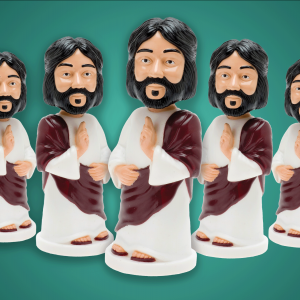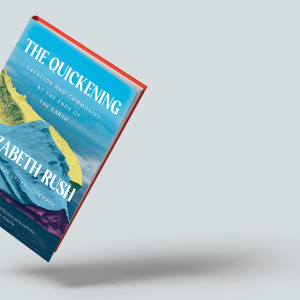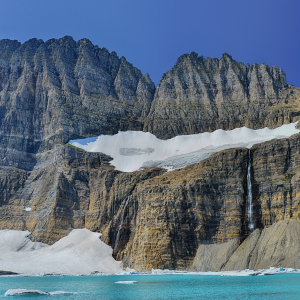
Avery Davis Lamb is a co-executive director at Creation Justice Ministries, where he works to protect, restore, and rightly share God’s creation.
Posts By This Author
Bobble-Head Jesus Is Not the Living Christ
DESPITE WHAT DASHBOARD Jesus figurines might suggest, there is no plastic in the Bible. None. It’s a 100 percent plastic-free zone. Jesus does, however, promise eternal life. While Christians have a wide array of interpretations about what that means, we generally agree that Jesus did not mean through polyresins and microplastics, which have a nearly eternal life of their own.
Christians are on the forefront of the battle to reduce fossil fuel use and address climate change. We understand that God has given us a mandate to serve and protect the Earth and its communities. Churches have divested from fossil fuels. Christians have risked arrest for effective legislation. Youth are leading the global defense of our planet and people.
But, as the pressure to transition to renewable energy increases and fossil fuel demand drops, the CEOs of petrochemicals want to keep their money pipelines open.
Over the past 70 years, annual production of plastics has increased nearly 230-fold, reaching 460 million tons in 2019. China, with weak human rights and environmental regulations, is now the world’s largest plastics manufacturer, accounting for nearly one-third of global production. If trends in oil consumption and plastics production continue at the current rate, plastics will make up 20 percent of fossil fuel consumption by 2050.
Studies track with increasing accuracy the total mass of microplastics found in adults around the world. It’s a lot. You may as well just chew on your credit card. Microplastics are linked with a variety of human health issues, including reproductive disorders, organ damage, and developmental impacts on children.
Is Giving Birth in a Time of Climate Change Hopeful or Fatal?
IN THE QUICKENING: Creation and Community at the Ends of the Earth, Elizabeth Rush explores both the quickening in her own body — the first feeling of the life moving in her belly — and the quickening pace of climate change.
In 2019, Rush embarked on a scientific sea-bound expedition to Thwaites Glacier in Antarctica, a writer among dozens of scientists. Their journey, via an icebreaker ship, was the first of its kind, bringing together geologists, paleoclimatologists, oceanographers, and a dozen other flavors of scientists to better understand how climate change is affecting a glacier at the end of the world.
Thwaites Glacier is enormous, bigger than the state of Florida and up to 4,000 feet thick. Because of its sheer size and vulnerability to collapse under warming, Thwaites is often referred to as the “Doomsday Glacier.” This one glacier contributes to about 4 percent of global sea-level rise, and whenever it collapses, it will cause global sea levels to increase by more than two feet.
Baptized in the Meltwater of a Dying Glacier
I KNOW WHAT it’s like to be baptized in the meltwater of a dying glacier. It feels like a plunge into all the emotions of living in our climate-changed world: joy, dread, awe, fear, love.
In August, a few of my college friends and I took a trip, something of a pilgrimage, to Glacier National Park in Montana. We wanted to visit the glaciers that are projected to die off in the coming decades. The Kootenai people call this place Ya·qawiswitxuki,“the place where there is a lot of ice.” It is a place burdened with names that it will hold on to even after the glaciers and ice disappear.
The geology of the park is like a cake cut open to show layers of sandstone, shale, and limestone — a portal into deep time. About 100 million years ago, in an event called the Sevier Orogeny, the mountains in Glacier formed as the forces of colliding tectonic plates thrust two billion years’ worth of sedimentary rock upward. Across 100,000-year cycles, glaciers formed and retreated, slowly whittling away at the rock and carving out dramatic valleys, moraines, arêtes and horns, cirques and tarns. During a simple four-hour hike, we walked through billions of years of sedimentation.
Walking through such a place makes this moment in history seem both insignificant and deeply important. Thousands of feet of layered sediment formed organically, with nearly no human influence, but the small sliver at the top will be markedly human. This Anthropocene layer in the geologic cake holds markers of nuclear bombs, cow manure, and a lot of plastic. It holds the most dramatic increase in carbon concentration and the accompanying increase in temperature. It holds the extinction of hundreds of creatures, which may soon include the western glacier stonefly and meltwater lednian stonefly, who require ice-cold clear streams to survive.
This layer is also the moment, a blink of an eye in geologic time, when the mighty glaciers disappear. It is estimated that by 2100, two-thirds of the world’s glaciers will be killed. The reality is more devastating in the eponymous national park, where all the glaciers are expected to be gone by the end of this century. I can’t predict all the impacts the park will feel over the next 75 years, but I imagine that the numerous hikers currently making pilgrimages to the glaciers will instead walk in funeral processions to plaques, like the one marking the death of the Okjökull Glacier in Iceland.


